_edited.jpg)
.png)
HEROES MUSEUM (PAGE 3)
We would love to take the time to honor our Heroes "That Walked Among Us". Remembering all of our heroes and giving them the full credit they deserve. Enjoy your time at our museum and let us know in the Virtual Village your thoughts. Thank You!
*NOTE*
UNMUTE the video to hear the audio. Thank You!
next expansion: exhibit c
We’re currently developing the next expansion of the Heroes Museum: Exhibit C.
As always, our dedicated Keeper of History is hard at work curating and researching the stories that define this chapter. While the exhibit is still in progress, we’d love to introduce some of the names and featured individuals you’ll soon encounter. Feel free to explore and learn more on your own while this page continues to evolve.
Stay tuned for what’s next.
Warm regards, Christopher A. Creative Director
Hazel Johnson Jackson
Biddy Mason- walked over 1700 miles barefoot, and caring for her three kids, she sued for her freedom...
Kimpa Vita: 1st black woman to say Christ was black in 1706 (she was murdered at the stake)
Clarence Wigington
Archibald Alphonso Alexander
Fitzroy "Buck" Newsome
Junius George Groves (Potato King)- 1st black billionaire
Sinah Estelle Kelley
Henrietta Lacks
Daniel Hale (1st successful open heart surgery)
Vivian Thomas
Black Angels
100 Doctors in WWI and WWII
Onesimus (smallpox cure)
Alice Ball (cure for leprosy) - 1915 (made it injectable)
Jewel Plummer Cobb (invented cure for leukemia) - stopping tumors from dividing
Marion Croak
Allen Allensworth
Mildred Blount
Marlon Briscoe (1967-Black Qb) - erased
Robert Williams & Mable
Prince Alimeyahu
David Griffin
Lucy Hughes Brown (co-founded the 1st black hospital) - 1st black woman to practice medicine in both North and South Carolina; co-founded training school for nurses
Oliver Lewis (won 1st Kentucky Derby - 1875)
Miniam Cox - 1st post master general... When a mob attempted to shut her down w/a mob, president Roosevelt responded w/full US protection
King Kamehameha of Hawaii
Pierre Neptune - true founder of Hennessy cognac (stolen)
Sebastian Lemba
Hazel Johnson-Brown,
Nurse, and Officer born
*Hazel Johnson-Brown was born on this date in 1927. She was a Black nurse and the first Black woman General in the United States Army.
Born in West Chester, Pa., Hazel Winifred Johnson was one of seven children. She always wanted to be a nurse, but racial prejudice created major obstacles. She was rejected when she applied to study at the local hospital after high school. The Johnson family’s white woman nurse saw the young Hazel’s potential and helped her gain admission to the Harlem Hospital School of Nursing, where she earned her nursing diploma in 1950. Johnson enlisted in the Army in 1955, seven years after President Harry S. Truman ordered the desegregation of the military. She took assignments across the country and in Asia, rising in the ranks as she impressed her superiors with her skill in the operating room.
In addition to her degree from the Harlem Hospital School of Nursing, she earned a bachelor’s degree in nursing from Villanova University in 1959, a master’s degree from Columbia University’s Teachers College in 1963, and a doctorate in educational administration from Catholic University in 1978. She served in Japan soon after enlisting. In the 1960s, she trained surgical nurses on their way to Vietnam. Her military decorations included the Distinguished Service Medal, the Legion of Merit, the Meritorious Service Medal, and the Army Commendation Medal.

She was twice named Army Nurse of the Year. In the 1970s, she was the Walter Reed Army Institute of Nursing director. She served as the chief nurse of the Army hospital in Seoul when she made military history in 1979, when she was promoted to brigadier general and, simultaneously, to the command of the 7,000 nurses in the Army Nurse Corps. She was the first Black woman to hold both posts. “Race is an incidence of birth,” Gen. Johnson-Brown said at the time of her promotion. “I hope the criterion for selection didn’t include race but competence.”
After her Army retirement, Gen. Johnson-Brown headed the American Nurses Association’s government relations unit and directed George Mason University’s Center for Health Policy. Her marriage to David Brown ended in divorce. In the interview with National Public Radio, Gen. Johnson-Brown said that she was not a “quiet dissenter” regarding the slights she suffered as a Black woman, in uniform and out. She recalled going with her mother to a hot dog stand in Philadelphia. Several times, the waitress walked past them to serve white customers first. When the waitress finally delivered their order, Gen. Johnson-Brown turned it away. “Now you eat it,” she told the waitress. To her mother, she said, “Let’s go.”
Hazel Johnson-Brown, 83, the first Black woman to become an Army general and a former chief of the Army Nurse Corps, died Aug. 5, 2011, en route to a hospital near her home in Wilmington, Del. She had Alzheimer’s disease.

Bridget "Biddy" Mason was born into slavery in the Deep South, walked to California as part of a pioneer caravan, fought for her freedom in court, and died a wealthy real-estate investor in Los Angeles. Her perseverance enabled her to find freedom and financial success, ultimately helping numerous others through her philanthropic work.
Mason was born into slavery in Mississippi, 1818. She was then owned by slaveholders in Georgia and South Carolina before being returned to Mississippi. Mason’s last enslaver was a Mormon convert who decided to journey to the Mormon community being established in what would become Salt Lake City, Utah. At this time Utah was still a part of Mexico. In 1848, Mason, then 30 years old, walked 1,700 miles behind a 300-wagon caravan destined for the Salt Lake Valley. Along the route, Mason was responsible for setting up and breaking camp; cooking the meals; herding cattle; and serving as a midwife. She also took care of her three young daughters, aged 10, 4, and a newborn.
bibby mason
In 1851, Mason’s enslaver moved once again, this time to California. Despite slavery being illegal in the new state, Mason and other enslaved people were taken along as property. Along the way, Mason met Charles H. and Elizabeth Flake Rowan, a free Black couple. The Rowan’s, and others, informed Mason of California’s free state status and urged Mason to legally contest her enslavement.
Mason Earns Her Freedom
After spending five years enslaved in California, Mason took legal action for her freedom. Mason’s enslavers attempted to relocate Mason and her family to Texas, where slavery was legal. Mason’s free Black friends intervened by alerting the local sheriff’s office, who took Mason and her family into protective custody. Mason’s case for freedom was sent to the courts, where Black people were not allowed to testify. However, events led to Mason stating her case in front of the judge. On January 21, 1856, in the case of Mason v. Smith, Los Angeles District Judge approved Mason’s petition. The ruling freed Mason and thirteen members of her extended family. This was the first ruling of its kind in California and set a precedent for future cases that came before California courts.
Mason, then 38 years old, moved her family to the growing town of Los Angeles. Despite California’s free state status, it was far from being a safe place for Black people. Many slave owners ignored the law, and there were bounty hunters who traveled the area. They would kidnap free Black people and try to return them to their former owners.

Mason, a savvy businesswoman, saved her earnings and made sound investment decisions in the rapidly growing town of Los Angeles. In 1866, Biddy Mason made her first land purchase at 48 years old. She paid $250 for a lot between 3rd and 4th on Spring Street. Spring connected with Main Street and was an important thoroughfare. Some accounts indicate that land investment was a major focus of her life. More reliable accounts show that it was likely that she was securing her family’s future by owning land on which they could live.
Two years later, she purchased more land. At that time, this area was considered “out of town.” Today it is in the heart of the older part of the city. In 1875, Mason sold the north half of the Spring Street property to K.H. Jones and Charles M. Wright for $1500. She sold another lot on Olive Street in 1884 for $2800. At that time, she also had the Spring Street parcel deeded to her grandsons, Robert and Henry. Her daughter, Ellen, Robert’s wife, also was given land to live on until she died. As the town grew, her property became prime urban lots, and she accumulated a fortune of nearly $300,000. That equates to approximately $10 million by today’s standards according to the CPI inflation calculator.
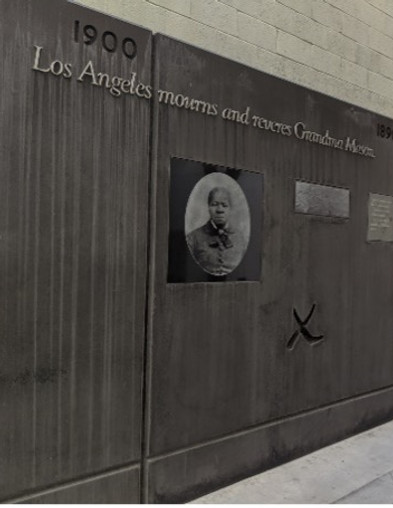
The Philanthropist
Biddy was very generous to all around her. She used her wealth to become a philanthropist for the entire L.A. community. She gave food and shelter to poor people of all races, donated to churches attended by both Black and white, and visited prison inmates with gifts and aid. Needy people often lined up for medical help in front of her house on Spring Street. Mason was instrumental in founding a traveler’s aid center and an elementary school for Black children. The opportunity to worship as they pleased was important to Black people in California. In 1872, Biddy and her son-in-law, Charles Owens, founded and financed the Los Angeles branch of the First African Methodist Episcopal Church. This was the first Black church in Los Angeles.
Bridget “Biddy” Mason died in L.A. on January 15, 1891 at the age of 73. She was buried in an unmarked grave in Evergreen Cemetery. On March 27, 1988, the mayor of L.A. and members of the church she founded held a ceremony, during which her grave was marked with a tombstone.
THE BLACK SAINT AND PROPHETESS OF KONGO: KIMPA VITA (DONNA BEATRIZ)

-
One of the first African women to fight against European dominance in Africa during the colonial period & expose the racism and misogyny in the Catholic church.
-
The founder of the first black Christian movement/Black Liberation Theology in Sub-Saharan Africa.
-
She fought all forms of slavery, and tried to reconcile Christianity with African religions and beliefs, teaching people that black saints mingled with white saints in paradise. This was revolutionary, since Catholic priests in the area (Capuchins) taught that ONLY white saints could be found in heaven
-
While still in her teens, she started a non-violent anti Colonial movement to liberate the Kingdom of Kongo and return it to its former glory.
-
Led thousands of her people to rebuild and repopulate Mbanza Kongo, the capital of the once glorious unified Kingdom of Kongo.
-
She was burned at the stake as a witch for heresy at Evululu.
Towards the end of the seventeenth century AD, both the combined states of Ndongo and Matamba, and also Kongo, fell victim to European predator activities where "executions, treachery, robbery, and violence became the order of the day." Even under these trying circumstances, a great woman emerged. Kimpa Vita also called Dona Beatriz continued the resistance against the Portuguese slave traders. Prophetess Kimpa Vita (Dona Beatriz) (circa 1684–1706) Saint of Kongo was burn at stake for heresy and the Pontiff refused the request for her rehabilitation in 1966.
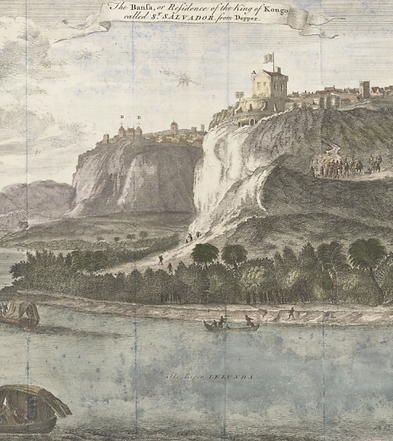
Early Life
Kimpa Vita was born of aristocratic family near Mount Kibangu in the Kingdom of Kongo soon after the death of King António I(1661–65), It is believed that she was connected to King António I who died at the battle of Mbwila (Ulanga) a battle orientated around the removal of the Portuguese from his region. Following António I death, was a time of internal strife, political unrest and civil war. As was the centuries old tradition with Kongolese nobles, she was baptised into the Roman Catholic church at birth and took Donna Beatriz as her baptismal name.
As a child Kimpa Vita had ‘gifts’, she constantly saw visions and dreamt of playing with angels. Due to her innate spirituality, Kimpa Vita was trained as a (Shaman) Nganga marinda, a individual who consults the supernatural world to solve problems within the community. As could be expected, the European missionaries did not like the existence of the Nganga marinda nor did they like the fact that the Kongolese widely accepted them as legitimate (despite two centuries of Catholicism).
The kingdom of Kongo (now a part of modern Angola and Congo), the wealthiest and most powerful state in the Atlantic region of Central Africa during the fifteenth and sixteenth centuries, began to dissolve in the seventeenth century under internal and external pressures. Portuguese military aggression emanating from the Angola colony to the south spurred the kingdom’s disintegration, notably at the battle of Mbwila in 1665 at which Portuguese troops killed the Kongo ruler Antonio I. The kingdom was plagued by devastating civil wars which fed the ravenous Atlantic slave trade. By the turn of the eighteenth century there was an immense political and cultural vacuum, the Kongo capital Mbanza Kongo (also known as São Salvador) had been abandoned and the kingdom had broken up into small territories ruled by warlords and members of the old Kongo nobility. Memories of Kongo’s past glory remained, however, and a series of popular movements developed out of the Kongo people’s desire to restore the kingdom to its former greatness.
Mission
With her training as a shaman and her identification as a Christian, Kimpa Vita began to be recognized as a prophetess. In 1704 at the age of 20 she had a near death experience when she appeared to die of a fever. When she had been resuscitated she believed that she now spoke with the voice of the patron saint of Kongo, and also incidentally the patron saint of Portugal, St. Anthony of Padua she believed Saint Anthony became incarnate in her body and so she became the physical manifestation of the saint, who addressed the kingdom’s problems through her.
Compelled by the Christian God to announce his word to restore the kingdom through adherence to a vision of Catholicism that was set firmly within Kongo history and geography. She also wanted to restore the former Kongo capital San Salvador.
She concerned herself with the restoration, spiritually and politically, of the Kongo Kingdom. Kimpa Vita’s religious ideology came as an answer to the prayers of many Kongolese people. In her message She combined traditional Kongolese beliefs with Catholicism. Creating her own her own Christian movement, known as Antonianism. She wanted a religious system that was set firmly within Kongo history and geography. From her visions she believed Kongo must reunite under a new king
& Antonianism was a way of doing this. Much to the dismay of the Catholic Church, Kimpa Vita quickly attracted a large following of common people, as well as some nobility who flocked to the city, which Kimpa identified as the biblical Bethlehem.
Rejecting missionary domination over Christianity, she preached that;

-
Kongo was the Holy Land described in the Bible
-
The Kongolese capital, Mbanza Kongo (also known as Sao Salvador) was the real site of Bethlehem .
-
Jesus was born in Mbanza Kongo and baptized not at Nazareth but in the northern province of Nsundi.
-
Jesus Christ and the other saints were black Africans
-
Mary was a slave of a Kongo marquis.
-
Heaven was for also for Africans .
-
The European church was not beneficial to Kongolese.
Kimpa Vita claimed all this had been divulged to her by God. She died every Friday and went to spend the weekend in heaven where she met God personally and discussed such topics as Kongo politics. Indeed, Kimpa Vita’s ideology may seem radical but not if you look at the history of Catholicism and Christianity in the Kingdom of Kongo and examine how the people learnt to adapt a foreign religion with their local traditions. They felt that the Christian missionaries were corrupt and unsympathetic to the spiritual needs of Kongolese Catholics.
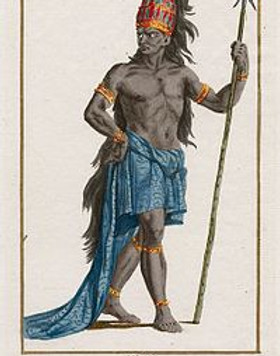
The History Catholicism
in Congo
The Kingdom of Kongo had been Catholic for two centuries by the time Kimpa Vita was born. In 1491 Nzinga a Nukwu, the king of Kongo at that time, was the first royal to be baptised. However, Nzinga a Nukwu ended up changing his mind and leaving his newly adopted religion after some years, it was his son Afonso I who surely established the church in Kongo and attempted to make the country a Catholic one. Afonso I went further by creating schools that taught European education and Christianity to the nobility. He also had members of the noble class sent to Portugal to further their education and worked with both educated Kongolese and Portuguese priests in his government.
This tradition continued with Afonso’s son, Henrique becoming the first bishop from sub-saharan Africa in 1518. Christianity grew further in the 16th century particularly under the reigns of Kings Alvaro I and Alvaro II who gave nobles titles such as Count, Duke and Marquis in the European manner. They also brought in relics such as bones of martyrs from Europe and established an embassy in Rome.
Universities Studying Slavery
Universities Studying Slavery (USS) is a consortium of over one hundred institutions of higher learning in the United States, Canada, Colombia, Scotland, Ireland, and England. These schools are focused on sharing best practices and guiding principles as they engage in truth-telling educational projects focused on human bondage and the legacies of racism in their histories.
This collective was created by the University of Virginia President’s Commission on Slavery and the University (PCSU) both to ensure that UVA’s important work would spread beyond Virginia and to respond to the calls for guidance from other schools. Since 2016, UVA has boldly led this growing movement, positioning the university as an internationally recognized center of educational leadership and excellence in the field.
Member schools are committed to research, acknowledgment, education, and atonement regarding institutional ties to the slave trade, to enslavement on campus or abroad, and to enduring racism in school history and practice.
-
Mentor and educate schools embarking on projects coming to terms with their
-
Promote collaboration among institutions examining histories of slavery and racism.
-
Pursue research that energizes active student learning and effective institutional decision-making.
-
Model collaborative multi-university public programs addressing enduring contemporary legacies of those pasts.
-
Educate innovatively a global public about how the afterlives of slavery and racism continue to shape elements of our contemporary world.
Universities Studying Slavery
Abilene Christian University
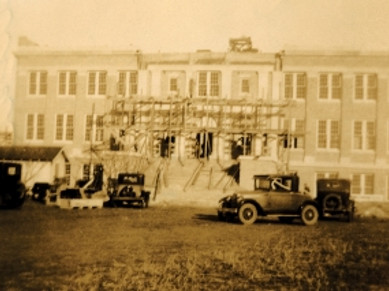

-
Abilene Christian University is a hub of rigorous academic excellence and devoted community. Through residential and online undergraduate and graduate programs, we equip students for lives of service leadership, empowering them through exceptional teaching that unlocks the power of their curiosity and prepares them to create the solutions that will address the opportunities of today and tomorrow.


-
Allegany College of Maryland (ACM) is a public community college located in Cumberland, Maryland. Founded in 1961, it offers a variety of programs, including 48 two-year degree programs, 31 certificate programs, and 10 letters of recognition. ACM has campuses in Cumberland, Bedford County, Pennsylvania, and Somerset County, Pennsylvania, providing comprehensive educational opportunities for students in various fields, particularly in health, hospitality, and technology. The college is accredited by the Middle States Commission on Higher Education and focuses on delivering quality education and support to its students.
Amherst College
.webp)

-
Amherst College, private, independent liberal-arts college for men and women in Amherst, Massachusetts, U.S., established in 1821 and chartered in 1825. The lexicographer Noah Webster was one of the founders of the college, which was originally intended to train indigent men for the ministry. It offers flexible programs of study in which students complete two years of courses in the humanities, social sciences, and natural sciences, after which they take seminars; they may also spend their third or fourth year doing independent research. Amherst is a member of the Five Colleges consortium, which also includes Hampshire, Mount Holyoke, and Smith colleges and the University of Massachusetts at Amherst. Originally a men’s college, Amherst admitted women as transfer students in 1975 and as first-year students beginning in 1976. Campus facilities include the Robert Frost Library, the Mead Art Museum, the Kirby Theatre, and the Pratt Museum of Natural History. The college administers the Folger Shakespeare Library in Washington, D.C., named for Amherst alumnus Henry Clay Folger. Total enrollment is about 1,600.
Appalachian State University

.webp)
-
Appalachian State University is a public institution that was founded in 1899. In the 2025 edition of Best Colleges, Appalachian State University is ranked No. #3 in Regional Universities South. It's also ranked No. #2 in Top Public Schools.
-
It has a total undergraduate enrollment of 19,405 (fall 2023), and the campus size is 1,200 acres. The student-faculty ratio at Appalachian State University is 16:1, and it utilizes a semester-based academic calendar.
-
Appalachian State University does not accept the Common Application and has a test-optional admissions policy. The school's in-state tuition and fees are $8,135; out-of-state tuition and fees are $25,768. 42% of first-year students receive need-based financial aid, and the average net price for federal loan recipients is $14,765.
-
The four-year graduation rate is 58%. Six years after graduation, the median salary for graduates is $43,663.
Athens State University


-
Athens State is one of the few universities in the nation dedicated solely to degree completion for transfer students, meaning we serve junior-level and senior-level undergraduate students in helping them finish their degrees. We also serve graduate students in their pursuit of career advancement through a master’s degree.
-
This makes us uniquely positioned to help students who want to finish or advance their degrees and ultimately maximize their earning potential. We have a long, rich history, but we are built for the un-traditional college student.
-
We place a genuine emphasis on producing the graduates that employers desire. We’ve become a destination for transfer students and for students who have paused their education — students who often find themselves balancing education with demands of adult life, including work and children.
bard college

.webp)
-
Bard College is a college of the liberal arts and sciences that seeks to inspire curiosity, a love of learning, idealism, and a commitment to the link between higher education and civic participation. The undergraduate curriculum is designed to address central, enduring questions facing succeeding generations of students. Bard offers Bachelor of Arts and Bachelor of Science degrees, 23 academic departments that offer over 40 major programs, as well as 12 interdisciplinary concentrations. The college was the first in the nation to offer a human rights major.


-
Founded in 1764, Brown is a leading nonprofit research university, home to world-renowned faculty, and also an innovative educational institution where the curiosity, creativity and intellectual joy of students drives academic excellence.
-
-
The spirit of the undergraduate Open Curriculum infuses every aspect of the University. Brown is a place where rigorous scholarship, complex problem-solving and service to the public good are defined by intense collaboration, intellectual discovery and working in ways that transcend traditional boundaries. As a private, nonprofit institution, the University advances its mission through support from a community invested in Brown's commitment to advance knowledge and make a positive difference locally and globally.
-
Providence, Rhode Island — Brown's home for more than two and a half centuries — is a vibrant place to live, work and study, a stimulating hub for innovation, and a city rich in cultural diversity.
.jpg)
.jpg)
-
Since its founding in 1885, Bryn Mawr College has been the preeminent college for women interested in the pursuit of wisdom necessary to challenge the world's expectations. Our community has repeatedly broken barriers to achieve greater equity through exceptional academics and a deep dedication to learning. Our more than 35 undergraduate majors span the humanities, sciences, social sciences, and arts. Two co-educational graduate schools offer selective master’s and Ph.D. programs across the Arts, Sciences, and Social Work, and our Postbaccalaureate Premedical Program is one of the most successful in the nation for placing students into medical school. We are dedicated to diversity, equity, inclusion, and accessibility, which serve as the engine for excellence and innovation, helping us pave the way for gender equity and inspiring brilliant minds who find life-long community here.
-
-
Designated by the Carnegie Classifications as a Research College for our contributions to academic scholarship, Bryn Mawr was the first women’s college to offer graduate degrees, evidence of our lasting commitment to the power of rigorous academic training. Today, we remain devoted to multidisciplinary education and unique undergraduate research opportunities. Our more than 200 majority-female faculty engage our more than 1,700 total student scholars with a strong liberal arts academic approach, giving them the freedom to follow their curiosity while maintaining high standards of excellence. Faculty are prolific in their scholarly endeavors, ranked #1 in research expenditure and #3 in research out of nearly 200 liberal arts institutions by Washington Monthly magazine. As a top Fulbright-producing institution, Bryn Mawr is committed to supporting our students holistically and to women’s education and empowerment.
-
-
Our campus, with its pioneering American Collegiate Gothic architecture and picturesque landscape, is recognized as one of the most beautiful in the country and provides a secure space for community building through athletics, 130+ student clubs, the arts, cultural performances, and visiting speakers and scholars. The campus culture is motivated by individual self-discovery and collective uplifting. Students learn to raise their expectations, embrace their confidence, and build self-reliance while living with integrity. Ninety-nine percent of seniors go on to achieve positive career outcomes within one year of graduation. Bryn Mawr students graduate as self-reliant leaders filled with purpose. Our 25,000+ strong alumnae/i network includes Nobel laureates; university presidents; leaders in government, social justice, and industry; groundbreaking scientists; and renowned scholars across various fields, including STEM and the humanities. Motivated to lead by example, our graduates never settle for what’s now but push for what’s next—always taking joy in the personal fulfillment and success that lifelong learning brings. Sourced from the Bryn Mawr College website: https://www.brynmawr.edu/about-college


-
Centre College’s mission is to prepare students for lives of learning, leadership, and service
-
The adoption of the strategic plan by the Centre College Board of Trustees in 2022 marked the beginning of a new focus for the College’s future. In addition to the implementation of the plan’s particular initiatives and the monitoring of progress, the planning process has included the continuing reassessment of the individual initiatives and of the goals themselves, based on changing conditions within the College and in the broader external environment.

.webp)
-
The mission of The Citadel is to “educate and develop our students to become principled leaders in all walks of life” by instilling the core values of The Citadel in a disciplined and intellectually challenging environment.
-
“It describes our core values of duty, honor, and respect and positions them as the basis of a principled leader’s frame of reference. It identifies and defines seven characteristics that principled leaders manifest in all they do.”
Glenn M. Walters, President of The Citadel, on Leadership Development at The Citadel
-
The Citadel’s most recognizable leadership brand is a form of values-based leadership called principled leadership. Principled leadership puts the leader’s character into action, guiding thoughts, words, and deeds to produce outcomes consistent with the core values of the organization.
.webp)
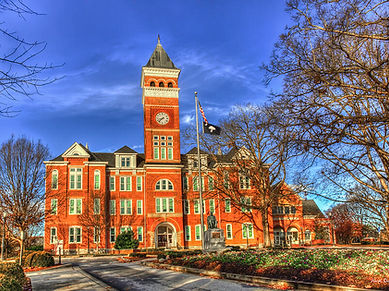
-
The mission of The Citadel is to “educate and develop our students to become principled leaders in all walks of life” by instilling the core values of The Citadel in a disciplined and intellectually challenging environment.
-
“It describes our core values of duty, honor, and respect and positions them as the basis of a principled leader’s frame of reference. It identifies and defines seven characteristics that principled leaders manifest in all they do.”
Glenn M. Walters, President of The Citadel, on Leadership Development at The Citadel
-
The Citadel’s most recognizable leadership brand is a form of values-based leadership called principled leadership. Principled leadership puts the leader’s character into action, guiding thoughts, words, and deeds to produce outcomes consistent with the core values of the organization.


The College of Charleston is unlike any other public university. We are a nationally recognized, public university in the heart of historic Charleston. We are a community that celebrates the power of diverse thought, where unique perspectives come together to create new ideas and brighter futures. We are a place where tradition inspires innovation and where students are empowered to think boldly, lead with purpose and make an impact. We are leaders in a region booming with opportunities in aerospace, automotive, medical, software/IT, and hospitality and tourism, connecting students directly to the industries shaping tomorrow.
We are extraordinary.
We are the College of Charleston. Extraordinary happens here.
.webp)

Continuing a tradition that was reinaugurated during the university's tercentenary in 1993, William & Mary begins each fall with our Opening Convocation to celebrate the start of the academic session. At 7:15 PM on the first day of fall classes, (Wednesday, August 27, 2025) faculty, staff and students gather at the Sir Christopher Wren Building to signify the beginning of the academic year and to officially welcome all of our entering William & Mary students.
From W&M News: Energy sector leader Darpan Kapadia ’95 to speak at Opening Convocation
At the conclusion of the ceremony each year, the official party leads those in attendance around the building to the opposite side. According to our tradition, all students who are new to W&M remain at the ceremony site with the university President. Then, at the tolling of the Wren Building bell, the President leads the group in a special procession through the portico of the building to the other side, where the new students are warmly welcomed by current members of the faculty, staff and student body. A festive campus-wide celebration follows for the entire campus community.
Not unlike the Commencement exercises which mark the close of an academic session, this ceremony is a time of affirming and enhancing the sense of community which exists at William & Mary. It is a time of achieving focus, of highlighting themes we know to be important to our current condition, and of reaffirming those things we value and share.
Columbia university

.webp)
Columbia University stands as one of the most prestigious institutions in the world. Founded in 1754, it boasts a rich history intertwined with the development of the United States. Located in New York City, this Ivy League school has been a hub for innovation, culture, and academic excellence. Did you know that Columbia has produced numerous Nobel laureates, U.S. Presidents, and influential thinkers? Its campus, nestled in the bustling city, offers a unique blend of historic architecture and modern facilities. Whether you're interested in its groundbreaking research, notable alumni, or vibrant student life, Columbia University has a wealth of fascinating facts waiting to be uncovered. Ready to learn more? Let's dive into 26 intriguing facts about Columbia University!|
Columbia University's Rich History
Columbia University, one of the oldest and most prestigious institutions in the United States, has a fascinating history. Let's dive into some intriguing facts about this Ivy League school.
-
01Columbia University was founded in 1754 as King's College by royal charter of King George II of England.
-
02It is the fifth oldest institution of higher learning in the United States.
-
03The university was originally located in Lower Manhattan before moving to its current location in Morningside Heights in 1897.
-
04During the American Revolution, classes were suspended, and the college's building was used as a military hospital.
community college of Baltimore county
.webp)
.jpg)
Since 1957, CCBC has offered accessible, high-quality education, inspiring generations of students to transform their lives, strengthening the regional workforce, and enriching our communities. More than 50,000 students each year come to CCBC to pursue degree, certificate and workforce training programs; to take courses for enrichment or professional development; and to build basic skills.
With multiple campuses and more than 60 fully online programs, we meet our students where they are. Graduates of CCBC's programs in business, education, the arts, health care, information technology, transportation and other areas enjoy guaranteed transfer to the University System of Maryland, and our CCBC Honors College graduates move on to many of the nation’s most selective colleges and universities.
dalhousie university (canada)


Photographs are powerful records of people, events and places, and are a critical form of documentary evidence valued by a variety of researchers, from historians to genealogists. Our collections include hundreds of thousands of images, including daguerreotypes, ambrotypes, tintypes, glass negatives, lantern slides, modern transparencies, flexible film negatives, photographic prints of all varieties, photo albums and photo-engraving plates.
Photographs can be found in our collections of private individuals, theatres, businesses and labour unions, but of particular significance are those images that provide visual documentation of the history of the University, from its built environment to student life and campus events. We also have some remarkable collections of professional photographers, including the Waldren Photographic Studios of New Glasgow, Nova Scotia.
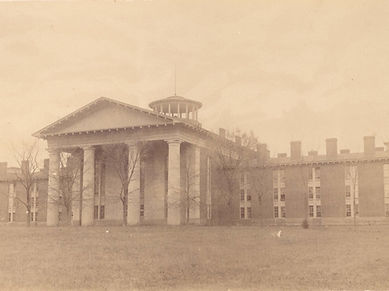
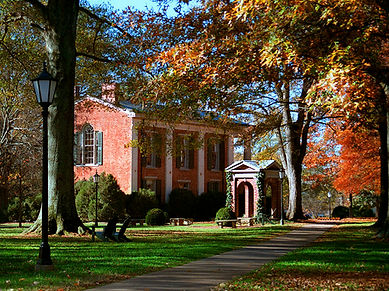
Immersed in the vibrant metro Charlotte region, Davidson College is a campus where century-old trees and brick buildings blend with a culture of innovation and an array of state-of-the-art facilities.
Davidson alumni describe how the college more than provided an exemplary education—it transformed their lives. The Davidson community empowers, inspires and educates people on how to understand their talents in light of what the world needs.
We are one of America's most selective liberal arts colleges, and academic potential, character, and accomplishments are the only factors considered in admission decisions—not your ability to pay.
.webp)

Dickinson is a nationally recognized liberal-arts college chartered in 1783 in Carlisle, Pa. We emphasize small classes with extensive opportunities for research, fieldwork and internships, and our challenging and innovative academic programs range from data analytics to neuroscience to international business.

.webp)
Elon University is a nationally recognized leader in engaged, experiential learning that prepares graduates to be creative, resilient, ambitious and ethical citizens of our global culture. Nestled in a grove of oaks, Elon was founded as “a college for the world,” where students find their calling and reach their full potential within an environment of rich and meaningful relationships, and where they become big thinkers and creative problem solvers in every facet of their lives.
Elon’s more than 7,000 undergraduate and graduate students learn through hands-on experiences and close working relationships with faculty and staff whose priorities are teaching and mentoring. The Elon curriculum is grounded in the traditional liberal arts and sciences with an emphasis on global experiences and career development. More than 70 undergraduate academic majors are complemented by professional and graduate programs in law, business, education and health care. Elon is ranked among the top national universities, with a No. 1 ranking in US News & World Report for excellence in undergraduate teaching for four consecutive years.
The university’s academic divisions include Elon College, the College of Arts and Sciences; the Martha and Spencer Love School of Business; the School of Communications; the Dr. Jo Watts Williams School of Education; the School of Health Sciences; and the School of Law, which is located in Greensboro, N.C.
Elon’s historic 690-acre campus in central North Carolina is designated as a botanical garden and includes the 56-acre Elon University Forest, a land preserve and natural area for scientific research, and Loy Farm, a center for environmental research and sustainability.
Elon is a member of the Coastal Athletic Association. The Phoenix athletics program includes 17 intercollegiate men’s and women’s sports in NCAA Division I.
Always evolving, Elon is an academic community that challenges, encourages and empowers our students to explore their passions, achieve their goals and change their communities for the better.

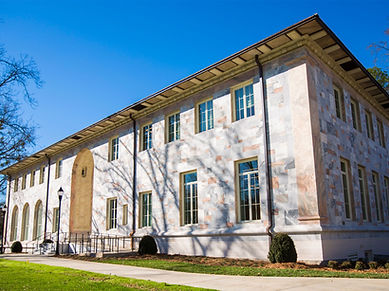
Somewhere deep in the woods of the North Georgia mountains, Aidan Conley has just pitched his tent and made camp with the rest of his Outdoor Emory trekking companions. A former Boy Scout and the trip’s leader, he has planned all the details in meticulous fashion: the trails they’re taking, the pace they’re setting and the roles — cooking, cleaning, first-aid — each member of the group is assuming.
Whenever he’s out in the wilderness like this, the urge to check his phone melts away entirely. Sometimes he strolls off to find a suitable rock where he can sit and just look at the leaves. This time, he sits in a circle with his fellow hikers, talking and laughing as they decompress after a long day on the trail.
With the demands of school and the ever-present lure of technology, Conley says, “It’s hard to get uninterrupted time with other people, and it’s also very hard to get uninterrupted time with yourself. So, I guess when I’m outside it’s a great way to get both.”
Participating in a club or recognized student organization like Outdoor Emory allows students the opportunity to slow down or speed up, and in either case to see the world anew: jousts and parries glimpsed through a latticed mask with Emory Fencing; the rivets of a chain running through greased hands at The Fixie, Emory Bike Social’s repair shop; or perhaps the ridges of an unusual mushroom studied up-close a few feet beyond the edge of the trail with the Oxford Mycology Club.
At Emory, students join organizations not only to find “their” people, but also to exercise, follow their passions, seek respite, build community, gain leadership experience and for countless other reasons.
Ammar Ul Haq, president of AHANA A Cappella singing group, says he joined his organization because he felt being part of a likeminded group enriched his overall educational experience.
“It’s been a way for me to relieve stress, connect with others and do something that doesn’t have to be bogged down with the pressure of setting up my career,” he says. “College is for both of those things: to set yourself up for the next chapter but also as a space to explore passions that make you a more interesting and colorful person.”
Below are some of the many ways Emory students are doing just that.
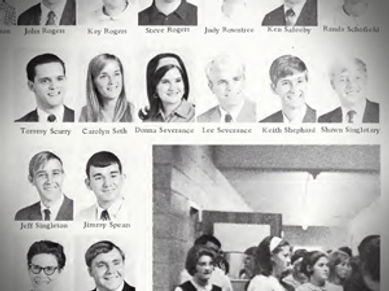
.webp)
Life at FMU offers students the opportunity to be fully immersed in the college experience. Whether you choose to live on our beautiful campus, commute to class, or study abroad, FMU provides every opportunity for student involvement, recreation, athletics, and personal growth and development. Check out our 14 NCAA teams in 9 sports, our robust assortment of organizations and clubs, unique travel and study abroad opportunities, and some much more at FMU!
Student Life supports the educational mission of the University by providing programs, services, and co-curricular experiences that contribute to student development and the FMU community.
Student Life seeks to develop the student experience by initiating platforms for self-expression and personal growth thereby enhancing student potential for success through leadership opportunities, citizenship education, networking, and community development.

Embracing globalization and all the benefits that it brings are intrinsic to our strategic priorities as an institution. We view our international students, who represent 17% of our student body, as critically important members of our community who help us understand how to embrace similarities and appreciate differences.
Among our long-term goals are to recruit international students from an ever-broader range of countries and regions, expand opportunities for engagement between domestic and international students, collaborate with international alumni to identify mentorship and networking opportunities for students, and reduce academic and socioeconomic barriers to off-campus study.
We also seek to increase opportunities to engage with our globalized home city of Lancaster, where 13% of residents are born outside the U.S.
.webp)

For nearly two centuries, Furman University has been the place where ambitious students discover their path to lifelong success. Here, high-impact education meets purposeful support in a vibrant campus community.
Education at Furman is intentionally personal, where faculty know students’ names and goals, where transformative experiences are guaranteed, and where every student graduates career-ready and confident.
visit us online

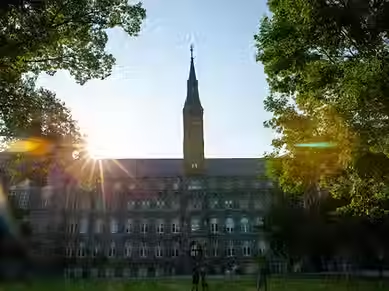
In 1789, Carroll secured the deed to one acre of land on a hilltop overlooking the village of Georgetown. He was appointed Archbishop of Baltimore in 1808.
Classes began in 1792. Within the first year, attendance grew to more than 40 students – some as far away as the West Indies. In 1817, the school awarded its first two bachelor’s degrees.
The Civil War (1861-1865) nearly closed Georgetown, as the student body dropped from 313 to 17 between 1859 and 1861. A total of 1,141 students and alumni enlisted in the war, serving in both the Union and Confederate forces.
After the Second Battle of Bull Run in Manassas, Virginia, in 1862, several campus buildings were turned into a temporary hospital. To mark the end of the Civil War, Georgetown students selected the colors blue and gray as the school’s official colors in 1876.


George Mason University (GMU) is a public research university in Fairfax County, Virginia, United States. Located in Northern Virginia near Washington, D.C., the university is named in honor of George Mason, a Founding Father of the United States.
The university was founded in 1949 as a northern branch of the University of Virginia. It became an independent university in 1972,
and it has since grown into the largest public university by student enrollment in Virginia. It has expanded into a residential college for traditional students while maintaining its historic commuter student-inclusive environment at both undergraduate and post-graduate levels, with an emphasis on combining modern professional education with a traditional liberal arts curriculum.
The university operates four campuses; the flagship campus is in the Fairfax, Virginia area. Its other three campuses are in Arlington, Front Royal, and Prince William County. It also operates a retreat and conference center in Lorton and an international campus in Incheon, South Korea. It is classified among "R1: Doctoral Universities – Very high research activity". Since the university's founding, two of its economics professors have received the Nobel Memorial Prize in Economics: James M. Buchanan in 1986 and Vernon L. Smith in 2002.
WEBSITELAST UPDATE:
SEPTEMBER 22nd 2025
Guilford College
Hampden-Sydney College
Hampton University
Harvard University
Hollins University
James Madison University
John Jay College of Criminal Justice
LaGrange College
Liverpool John Moores University (United Kingdom)
Longwood University
Louisiana State University
Loyola University Maryland
Mars Hill University
McGill University (Canada)
Mercer University
Meredith College
Morgan State University
Norfolk State University
Princeton Theological Seminary
Queens University (North Carolina)
Randolph-Macon College
Rice University
Roanoke College
Rutgers University Scarlet & Black Project
Saint Louis University
Salem Academy and College
Southern Illinois University Edwardsville
Southern University Law Center
Southwestern University
Stillman College
Sweet Briar College
Texas Christian University
Tougaloo College
Towson University
Trinity College (Connecticut)
Trinity University (Texas)
Tulane University
Universidad del Rosario (Colombia)
University of Aberdeen (United Kingdom)
University of Bristol (United Kingdom)
University College Cork (Ireland)
University of Cambridge (United Kingdom)
University of Cincinnati
University of Durham (United Kingdom)
University of Georgia
University of Glasgow
University of King’s College (Canada)
University of Liverpool
University of Manchester (United Kingdom)
University of Maryland
University of Mississippi
University of New Brunswick (Canada)
University of North Carolina at Chapel Hill
University of Nottingham (United Kingdom)
University of Pennsylvania
University of Richmond
University of South Carolina
University of the South (Sewanee)
University of Virginia (PCSU)
University of Warwick
Vanderbilt University
Virginia Commonwealth University
Virginia Military Institute
Virginia State University
Virginia Tech
Wake Forest University
Washington & Lee University
Washington University in St. Louis
Wesleyan College (Georgia)
Western Kentucky University
Wofford College
Xavier University
Yale University